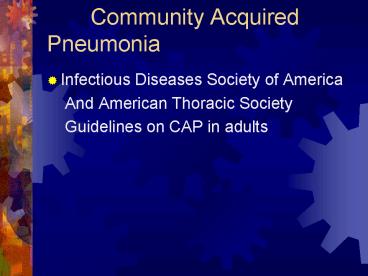Community Acquired Pneumonia - PowerPoint PPT Presentation
1 / 15
Title:
Community Acquired Pneumonia
Description:
Macrolide ( clarithromycin or erythromycin) or doxycycline. ... cefpodime and cefuroximine (500 bid) doxycycline is an alternative to the macrolide. ... – PowerPoint PPT presentation
Number of Views:206
Avg rating:3.0/5.0
Title: Community Acquired Pneumonia
1
Community Acquired Pneumonia
- Infectious Diseases Society of America
- And American Thoracic Society
- Guidelines on CAP in adults
2
Community acquired pneumonia
- Presence of an infiltrate on chest x ray as well
as clinical signs and symptoms (such as fever,
productive cough and chest pain)
3
Diagnostic testing
- Patients should be screened for hypoxia with
pulse oximetry. - Outpatients and hospitalized patients without
cormobidities pretreatment sputum and blood
cultures are optional. - Patients with severe cap should have blood and
sputum cultures and urinary antigen tests for
Legionella pneumophila and streptococcus
pneumoniae. - Urinary antigen testing is also advised for
patients who fail outpatient therapy.
4
Curb-65 criteria
- One point each for confusion, uremia, respiratory
rate, low blood pressure, age 65 or older. - And the Pneumonia Severity index can be used to
determine treatment setting
5
Determine Treatment Setting
- Curb-65 of 2 indicates inpatient treatment or
intensive home health care services. Depending on
several factors such as family support.
6
ICU admission
- Patients requiring vasopressors or mechanical
ventilation. - Severe CAP having three of the following
respiratory rate of 30, hypoxemia( PaO2/FiO) of
250, multilobar infiltrates, confusion, uremia,
leukopenia, thrombocytopenia or hypotension.
7
Outpatient treatment
- Healthy patients whove had no antibiotic within
3 months. Macrolide ( clarithromycin or
erythromycin) or doxycycline. - Patients with cormobidities or use of an
antibiotic within three months use a respiratory
fluroquinolone (moxifloxin, gemifloxacin, or
levofloxacin) or a B-lactam plus a macrolide.
High dose amoxicillin (1 gm tid)
8
Outpatients continued
- Or amoxicillin-clavulanate(2 gm bid) alternatives
include ceftriaxone,cefpodime and cefuroximine
(500 bid) doxycycline is an alternative to the
macrolide. - Macrolide resistant areas S. pneumoniae infection
rates greater than 25 use a flouroquinolone or a
b-lactam or cephalosporin and doxycycline.
9
Inpatients
- Respiratory fluoroquinolone or the combination of
B-lactam (cefotaxime, ceftriazone or ampicillin)
and macrolide. - In some patients ertapenem and macrolide can be
used when there is anaerobic and drug resistant
S. pneumoniae infection
10
Icu treatment
- B-lactam (cefotaxime,ceftriaxone, or
ampicillin/sulbactam) in combination with - Azithromycin or a respiratory fluroquinolone.
- Penicillin allergies use aztreonam with a
fluoroquinolone
11
Icu continued
- Pseudomonas infection suspected use
antipneumococcal, antipseudomonal B-lactam with
either cipro or levofloxin. Alternative B-lactam
and aminoglycoside and azithromycin or a
fluoroquinolone. - Community acquired methicillin resistant (MRSA)
Add vancomycin or linezolid.
12
Influenza A
- Treat with Zanamivir or Oseltamivir within
- 48 hours of symptoms.
- If symptoms longer and are hospitalized they also
can be given either medication.
13
Patients with influenza with exposure to live
poultry
- Test the patient for H5N1 infection, place on
droplet precautions and treat with both
antivirals and antibacterial.
14
Prevention
- Pneumococcal polysaccharide vaccine is
recommended for patients aged 65 years old and
for younger higher risk patients. If given prior
to age 65 a second dose is recommended also. - Inactivated Influenza vaccine is recommended for
patients aged 50 or for younger persons at risk
for complications of influenza, household
contacts of high risk individuals and health care
workers. Therefore, at least 2/3 of US population
qualifies for it.
15
In Summary
- Decide on appropriate treatment setting.
- Diagnostic testing should be done when needed.
- Begin empiric antibiotic therapy
- Practice preventive measures through immunization
of patients.































